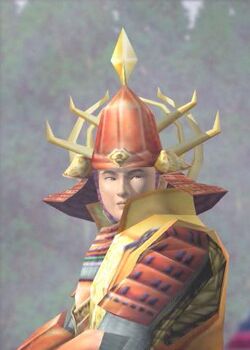| Hiroie Kikkawa | |
|---|---|
 | |
|
Games |
Samurai Warriors |
|
Clan |
Toyotomi |
|
Weapon |
Sword |
|
Battles |
Sekigahara |
Hiroie Kikkawa 1st appeared in Kessen.
Games[]
Samurai Warriors[]
In Samurai Warriors 2, Kikkawa is stationed at Mt. Nangu with Hidemoto Mori. He curses that he would join Ieyasu if Ekei wasn't with him. If Ekei is defeated, Kikkawa and Mori will defect to the Tokugawa. In Yukimura and Motochika's versions of the stage, Kikkawa will actively take part of the battle under the Eastern Army's standard along with Hidemoto. If the player fights for the Western Army and moves close to Hidemoto or Hiroie, they will defect, even if Ekei is still alive. In Mitsunari Ishida and Ginchiyo Tachibana's dream stages, he will turn against the Western Army along with Hidemoto and Hideaki Kobayakawa.
Kessen[]
Before the Battle of Sekigahara in Kessen, Kikkawa contacts Naga and promises to defect. He becomes one of Hidemoto's advisors during the battle and tries to convince his lord to join the East. Players who choose to play the Western Army will never see him accept their orders, even if they win Sekigahara.
Charecter Information[]
Voice Actors[]
- Kirby Morrow - Kessen (English)
- Taiki Matsuno - Kessen (Japanese)
History[]
Kikkawa Hiroie (吉川広家?) (December 7, 1561-October 22, 1625) was a Japanese daimyo of the Azuchi-Momoyama period through early Edo period.
Hiroie's father was Kikkawa Motoharu and his mother was a daughter of Kumagai Nobunao. He initially was named Tsunenobu(経信) and made his debut on the battle field on 1570 against Amago Katsuhisa with his father. On 1583, he was sent to then the de facto ruler Hashiba Hideyoshi as a hostage.
From 1586 to 1587, his father and his elder brother Kikkawa Motonaga both died and he became the head of Kikkawa clan. Around this time, he changed his name to Hiroie. Unlike his father and his elder brother who was known for the battlefield bravery, Hiroie preferred strategy and diplomacy to win on a battlefield and was highly praised by Hideyoshi for holding Mori clan together after the death of Kobayakawa Takakage. During the Seven-Year Korean War, he is noted for the successful defeat of a much larger Ming army at the battle of Ulsan castle.
In the Battle of Sekigahara on 1600, after realizing that Mori Terumoto would be made the leader of pro-Toyotomi forces by Ishida Mitsunari, Hiroie made a secret pact through Kuroda Nagamasa of his intention to side with Tokugawa Ieyasu in exchange for the protection of Mori clan's domains. On the day of the actual battle, September 15, Hiroie ordered all Mori clan's forces to standstill until Tokugawa forces emerged victorious. After the battle, Ieyasu decided against the secret pact and reduced the Mori clan to Suo and Nagato but this is still a lenient punishment when one considers that almost all other daimyo who opposed Ieyasu lost their domains and that Terumoto served as the leader of the opposition. While Ieyasu recommended that Hiroie to take over Mori clan and rule, Hiroie declined stressing that he had only intended for the clan's continuation.
In 1614, Hiroie was succeeded by Kikkawa Hiromasa, his eldest son.